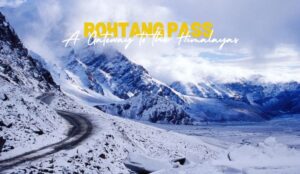🏔️Welcome to our comprehensive guide on Kuari Pass, a captivating trekking destination nestled in the majestic Himalayas.🏞️ If you’re an adventure enthusiast seeking breathtaking views, challenging trails, and a rendezvous with nature’s grandeur, then Kuari Pass is the perfect destination for you.🌄
Exploring Kuari Pass: A Trekker’s Dream
Kuari Pass, also known as the “Curzon Trail,” is a hidden gem in the Garhwal region of Uttarakhand, India. This trail was named after Lord Curzon, the former Viceroy of India, who was captivated by its mesmerizing vistas during his visit. At an altitude of approximately 12,516 feet, Kuari Pass offers a trekking experience that combines awe-inspiring landscapes, rich biodiversity, and a glimpse into the local culture.
Trekking Routes and Itinerary
Route 1: Joshimath to Kuari Pass
The classic route begins at Joshimath, a quaint town renowned for its spiritual significance and breathtaking beauty. The trail takes you through dense forests of oak, pine, and rhododendron, creating a colorful spectacle during the spring months. As you ascend, the panoramic views of Nanda Devi, Kamet, and other prominent peaks unfold before your eyes. The trek usually spans over 4 to 6 days, allowing trekkers to acclimatize and soak in the natural splendor.
Route 2: Ghat to Khullara via Kuari Pass
This alternative route commences at Ghat, offering trekkers a unique perspective of the region. The trail passes through picturesque villages, terraced fields, and pristine meadows, providing a glimpse into the lives of the local communities. The highlight of this route is the Khullara Ridge, which offers astonishing vistas of the surrounding peaks and valleys.
Best Time to Embark on the Kuari Pass Trek: A Seasonal Guide
Spring: March to April
Spring marks the beginning of the trekking season in Kuari Pass. As the snow melts, the trail transforms into a canvas painted with vibrant rhododendron blooms and lush greenery. The months of March to April offer moderate temperatures, making it an ideal time for trekkers. The crisp air and clear skies provide excellent visibility of the surrounding peaks, allowing you to fully immerse yourself in the panoramic vistas. Be prepared for slightly colder nights, and ensure you have warm clothing to stay comfortable.
Summer: May to June
Summer is another popular season to embark on the Kuari Pass trek. During these months, the weather is relatively warmer, and the trails are well-defined due to the melting snow. The breathtaking vistas of the Himalayan range are on full display, creating picture-perfect opportunities. The longer daylight hours allow for leisurely treks and ample time to appreciate the natural beauty. However, keep in mind that summer is also the peak tourist season, so expect more fellow trekkers on the trail.
Autumn: September to October
Autumn, with its clear skies and mild weather, is a prime time for the Kuari Pass trek. The monsoon rains have subsided, leaving behind fresh landscapes and lush foliage. The trails are dry, providing a stable footing, and the reduced humidity enhances your overall trekking experience. September to October also sees fewer crowds compared to the summer months, allowing you to enjoy a quieter and more serene journey.
Winter: November to February
For those seeking a unique and challenging experience, winter offers a different perspective of the Kuari Pass trek. The months of November to February bring snowfall, blanketing the landscape in a pristine white coat. The trail transforms into a winter wonderland, and the crisp air adds a touch of magic to your journey. However, trekking in winter demands more preparation and the right gear, including proper winter clothing, waterproof footwear, and caution while navigating snowy terrain. This season is recommended for experienced trekkers and adventure enthusiasts who are well-equipped to face the cold.
Captivating Highlights
1. Panoramic Views
Kuari Pass is renowned for its panoramic views that leave trekkers spellbound. From the pass, one can witness a stunning 360-degree panorama of the Himalayan range, including Nanda Devi, Dronagiri, Kamet, and Chaukhamba peaks. The experience of watching the sunrise over these snow-capped giants is nothing short of magical.
2. Enthralling Flora and Fauna
The trek takes you through diverse ecosystems, from lush forests to alpine meadows. Keep an eye out for the vibrant rhododendron blooms and a variety of bird species that call this region home. If luck is on your side, you might even spot the elusive Himalayan musk deer or the Himalayan tahr.
3. Cultural Immersion
Interact with the warm and hospitable villagers along the way to truly understand the local way of life. Indulge in their traditional cuisine and learn about their customs, adding a cultural dimension to your adventure.
Essential Tips for a Successful Trek
Fitness Preparation: Building the Foundation
1. Cardiovascular Fitness: Stamina Building Prioritize cardiovascular exercises like brisk walking, jogging, cycling, and swimming. Elevating your heart rate through these activities enhances endurance, making uphill climbs and long stretches of the trail more manageable.
2. Muscle Strength: Core and Legs Strengthen your core and leg muscles for uphill and downhill terrains. Incorporate squats, lunges, and planks to bolster key muscle groups that provide stability and support.
3. Gradual Progression: Safe Advancement Gradually intensify workouts to prevent overexertion. Interval training mirrors trail demands, preventing injuries and allowing your body to adapt progressively.
4. Nutrition and Hydration: Fuel Wisely Consume protein-rich foods for muscle repair and carbohydrates for sustained energy. Stay hydrated to optimize performance and recovery.
5. Rest and Recovery: Vital Reprieve Prioritize ample sleep for muscle repair and overall well-being. Listen to your body’s cues, avoid overtraining, and embrace rest.
Gear Essentials: Equipping Yourself for Success
Investing in the right gear can significantly enhance your comfort and safety during the Kuari Pass trek. Here’s a comprehensive list of gear that should find a place in your backpack:
- Trekking Shoes: Sturdy and well-fitting trekking shoes with good ankle support are essential to tackle varying terrains.
- Layered Clothing: Opt for moisture-wicking base layers, insulating mid-layers, and a waterproof outer layer to adapt to changing weather conditions.
- Backpack: Choose a backpack that is spacious enough to carry your essentials while distributing the weight evenly.
- Sun Protection: Don’t underestimate the power of the sun at higher altitudes. Pack sunscreen, a wide-brimmed hat, and UV-blocking sunglasses.
- Water Bottle: Stay hydrated by carrying a reusable water bottle. Sip water regularly to combat the effects of altitude.
- Snacks: Energy-boosting snacks like nuts, energy bars, and dried fruits will keep your energy levels up during the trek.
- First Aid Kit: A basic first aid kit including bandages, antiseptics, pain relievers, and any prescribed medications is a must.
Hydration Strategies: Navigating Altitude Challenges
Proper hydration is pivotal during any trek, especially at higher altitudes where the air is thinner and dehydration can set in more quickly. Here’s how you can ensure you stay hydrated throughout the Kuari Pass trek:
- Start Early: Begin your day with a glass of water and continue to hydrate consistently.
- Sip Regularly: Carry a water bottle and take small sips at regular intervals rather than chugging large amounts infrequently.
- Avoid Alcohol and Caffeine: These substances can contribute to dehydration, so it’s best to limit their consumption during the trek.
- Herbal Teas: Herbal teas like ginger or chamomile can help alleviate altitude-related symptoms while providing hydration.
Acclimatization: Adapting to Altitude Changes
Altitude sickness is a genuine concern during treks at higher elevations. Acclimatization is the process by which your body adjusts to the reduced oxygen levels, preventing altitude-related illnesses. Here’s how to ensure a safe ascent:
- Gradual Ascent: Avoid rapid ascents that don’t allow your body sufficient time to acclimatize. Choose trekking itineraries that incorporate rest days and gradual altitude gains.
- Stay Active: On rest days, engage in light activities that keep your blood flowing without exerting excessive effort.
- Stay Hydrated: Hydration aids acclimatization, so continue to sip water regularly even on rest days.
- Recognize Symptoms: Be vigilant for symptoms of altitude sickness, which include headache, dizziness, nausea, and shortness of breath. If symptoms worsen, descend to a lower altitude.
In Conclusion
Kuari Pass stands as a testament to nature’s magnificence, a destination that promises not just a trek, but a transformative experience. The allure of its landscapes, the thrill of conquering its trails, and the warmth of its people make it a journey worth embarking on.
So, pack your bags, lace up your boots, and let Kuari Pass unveil its secrets as you tread along its enchanting trails.
FAQs
1. What Accommodation Options Are Available?
Along the trail, you’ll find guesthouses and trekking lodges. These accommodations offer basic facilities, making your trek comfortable.
2. Can I Rent Trekking Gear Locally?
Yes, you can rent trekking gear like sleeping bags, trekking poles, and jackets in Joshimath before starting the trek.
3. Are There any Emergency Services Along the Trail?
Basic medical facilities are available at some points along the trail. It’s advisable to carry a basic first aid kit and any necessary medications.
4. How Do I Obtain Permits for the Trek?
You’ll need to obtain permits from the Forest Department in Joshimath. These permits are required for entry into the Nanda Devi National Park.
5. What’s the Mobile Network Coverage Like?
Mobile network coverage is limited beyond Joshimath. BSNL and Jio networks tend to have better connectivity compared to others.





